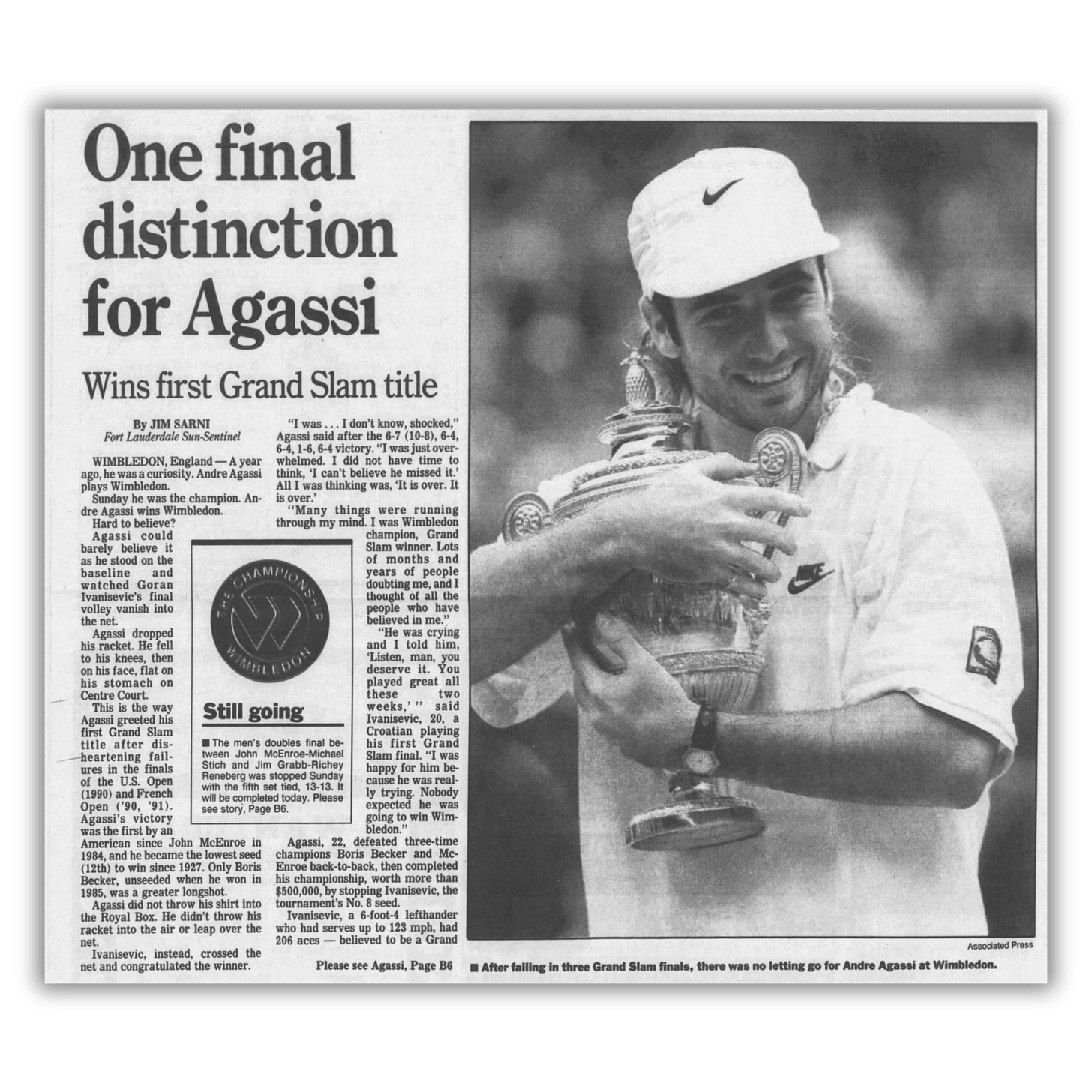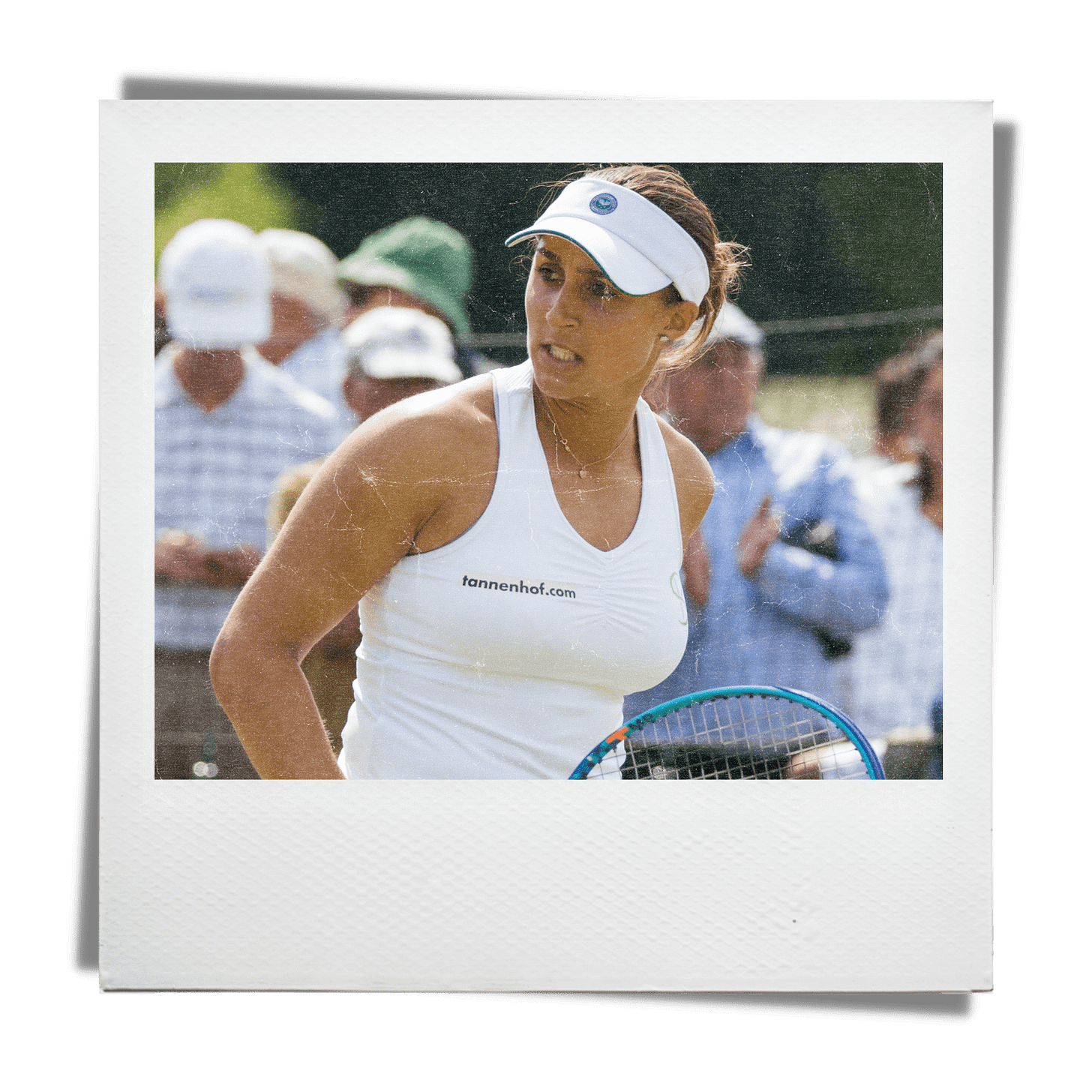The 16 Wimbledon finalists to have faced doping cases - Town Square #19
In 2019, three players competed in the Wimbledon finals who have failed doping tests at one point in their careers. A further five Wimbledon junior finalists faced their own problems as professionals.
Every Monday and Thursday, I publish a press-round up of all the doping and sports medicine stories in the media from the past seven days. You can read an example of these round-ups here (link).
Since last year’s Wimbledon, the tennis world has been plagued by major doping scandals.
Two world number one players, a Wimbledon doubles champion and several other players have all been banned from the sport over this time.
Despite this influx of cases, the current director of tennis anti-doping programme Nicole Sapstead believes “the vast majority of players compete clean” (link).
With Wimbledon starting tomorrow, here is a list of the tournament’s winners and runner-ups who have faced doping cases at some point during their careers.
In fifteen of the sixteen cases, it was concluded that the players had not intended to cheat.
16. Mats Wilander (SWE) - 1986 Wimbledon doubles winner
Substance: cocaine (stimulant)
At the 1995 French Open, the 7-time grand slam champion Mats Wilander tested positive for cocaine (link). At the same tournament, Karo Novacek, who was coached by Wilander in 1994 (link), also tested positive for the same drug. To much derision, Wilander claimed he had used cocaine unknowingly but was eventually banned for three months.
Unlike today, cocaine was used as a stimulant to enhance performance at the time (link). In 1979, the French Open champion Yannick Noah raised alarm that amphetamines and cocaine were being used widely in tennis. The former British player David Lloyd also said, “It’s not unknown for players to sprinkle cocaine on their wristbands and sniff it during a match”.
Wilander, who is now a Eurosport commentator, won the 1986 men’s double tournament at Wimbledon with his partner Joakim Nyström.
15. Andre Agassi (USA) - 1992 Wimbledon singles winner
Substance: amphetamine (stimulant)
In 1997, Andre Agassi tested positive for the stimulant methamphetamine, but he lied to an ‘independent panel’ at the Association of Tennis Professionals (ATP) that he had unknowingly consumed a spiked drink belonging to his assistant ‘Slim’.
Agassi was cleared of wrongdoing and his case was never publicly disclosed by the ATP; this was purportedly not unusual at the time. The former president of the Spanish Tennis Federation Pedro Munoz has previously claimed that several cases involving Spanish players in the nineties were also kept secret (link).
Agassi addressed the incident in his autobiography and admitted to snorting the street drug ‘crystal meth’ which he claims was the source of his positive test.
“I say Slim, whom I've since fired, is a known drug user, and that he often spikes his sodas with meth – which is true. Then I come to the central lie of the letter. I say that recently I drank accidentally from one of Slim's spiked sodas, unwittingly ingesting his drugs. I ask for understanding and leniency and hastily sign it: sincerely,” wrote Agassi (link).
After the player’s confession, the World Anti-Doping Agency sought clarification from the ATP concerning his statements (link). Agassi was also intensely questioned about the incident, and doping, by the Irish journalist Paul Kimmage (link).
Agassi won Wimbledon in 1992 and lost to Pete Sampras in the 1999 final.
14. Martina Hingis (SUI) - 1997 Wimbledon singles winner
Substance: cocaine (stimulant)
At Wimbledon 2007, the Swiss player Martina Hingis tested positive for cocaine ten years after winning the tournament as a sixteen-year-old.
Hingis, a five-time grand slam singles champion, was banned for two years by the International Tennis Federation (ITF) after contesting unsuccessfully that the positive finding was invalid.
“Whether or not the player’s denial of having deliberately taken cocaine is true, we agree with the ITF that the player cannot discharge the burden on her of establishing how it entered her system,” read the ITF decision in Hingis’ case (link).
Hingis returned from her doping ban and won the Wimbledon women’s doubles tournament in 2015.
13. Maria Sharapova (RUS) — 2004 Wimbledon singles winner
Substance: meldonium (metabolic modulator)
At the 2016 Australian Open, the five-time grand slam champion Maria Sharapova tested positive for the metabolic modulator meldonium and was consequently banned for fifteen months (link).
In 2006, Sharapova was prescribed the then-legal drug by a Russian doctor to protect her ‘health, including heart issues, prior to demanding physical activity’. Sharapova would also increase her dosage of meldonium prior to ‘matches of special importance’ played in ‘demanding conditions’.
However, Sharapova failed to realise that meldonium was added to the WADA Prohibited List in 2016 and consequently tested positive.
“Ms. Sharapova did not disclose on her antidoping control forms her use of the prohibited substance, a factor that clearly weighed heavily in the mind of the CAS Panel,” read the decision.
Since 2016, two Russian tennis players have since tested positive for meldonium, including Daniil Savelev, who worked with Sharapova’s former assistant coach in 2023 (link). Savelev, like Sharapova, was cleared of intent to cheat after he accidently took his grandmother’s meldonium tablets (link).
Sharapova became a Wimbledon singles champion in 2004 and was a runner-up in 2011.
12. Tamira Paszek (AUT) - 2005 Wimbledon junior finalist
Method: autologous blood treatment
In July 2009, the 18-year-old Austrian player Tamira Paszek said during a Fed Cup press conference that a Mongolian doctor had removed a small amount of her blood, enriched it with homeopathic ‘essences’ and re-injected into her back to treat an injury (link).
After Paszek was informed by a journalist that the treatment was considered a prohibited blood doping technique by WADA, she self-reported herself to the Austrian anti-doping agency.
“I couldn't get out of bed in the morning, but now it's slowly getting better,” Paszek explained. “The pain is lessening with each injection, so that's a good sign”.
A hearing was consequently held by the agency’s legal commission and proceedings against the young player were terminated after it was concluded that she bore ‘no fault’ (link).
Paszek, who has a career high ranking of 26, lost in the 2005 Wimbledon girl’s singles against Agnieszka Radwańska.
11. Sara Errani (ITA) - 2014 Wimbledon doubles winner
Substance: letrozole (aromatase inhibitor)
In 2017, the Italian tennis player Sara Errani tested positive for letrozole which is an aromatase inhibitor that reduces the amount of oestrogen in the body.
Errani was dealt a reduced ten-month suspension after the Court of Arbitration for Sport accepted that her mother had accidently dropped her breast cancer medication into her tortellini.
“Fulvia Errani believes that one of her Femara [letrozole] pills must have accidentally dropped into either the beef stock or the tortellini that she prepared,” read the decision. “This is because, on at least one previous occasion, more than one pill had dispensed from the blister package when she tried to take out just one pill, and fallen onto the working surface in the kitchen” (link).
Several years earlier, Errani had ended her association with Lance Armstrong’s doctor Luis Garcia del Moral after he was banned for systematically doping cyclists in 2012 (link). Del Moral worked with players from the Tennis Val academy in Valencia, Spain for ten years. One of Armstrong’s US Postal teammates described Del Moral as the type of doctor who “would run into the room and you would quickly find a needle in your arm” (link).
Errani won the Wimbledon women’s doubles title with her partner Robert Vinci in 2014.
10. Mikael Ymer (SWE) - 2015 Wimbledon junior finalist
Offence: whereabouts
Over the course of seven months in 2021, the Swedish tennis player Mikael Ymer missed three doping tests and was consequently suspended for eighteen months (link).
Ymer, who was ranked 50 in the world at the time, did not contest his failure to make himself available for two of the drug tests. For one of those controls, Ymer told a first instance tribunal that he was in Barcelona when he was in fact travelling to Ethiopia (link).
In relation to the Swedish player’s third missed test, he claimed that the doping control officer should have made more effort to contact him before a tournament in Roanne, France. However, Ymer’s agent had not updated WADA’s whereabouts management system with the correct details of the hotel the player was staying at.
In 2015, Ymer was defeated by the American player Reilly Opelka in the Wimbledon boy’s final.
9. Dayana Yastremska (UKR) - 2016 Wimbledon junior finalist
Substance: mesterolone
In 2020, the Ukrainian tennis player Dayana Yastremska tested positive for the anabolic steroid mesterelone following a doping control conducted during the tennis off-season.
An independent tribunal accepted that the player had ingested the drug after ‘kissing’ her boyfriend, who had presumably consumed mesterelone in some form, on the morning of the test (link). Yastremska was found to have bore ‘no fault’ and avoided a period of suspension.
“Specifically, the transfer of the Mesterolone to her could have occurred via a number of means including: (i) consumption of [redacted] powder on Mr fingers lips, mouth, and/or fingers during kissing; (ii) consumption of saliva during kissing,” read the decision.
In 2016, Yastremska, who has a career high ranking of 21, lost to the Russian player Anastasia Potapova in the Wimbledon girl’s singles final.
8. Marcelo Melo (BRA) - 2017 Wimbledon doubles winner

Substance: isometheptene (stimulant)
At the Wimbledon warm up tournament ‘Queens’ in 2007, the Brazilian doubles player Marcelo Melo tested positive for the stimulant isometheptene.
Melo, a former doubles world number one, was banned for three months after the ITF accepted that he had accidentally taken the medication Neosaldina, which contained the drug, to treat a migraine.
“We felt the sanction was an appropriate one,” said the ITF’s anti-doping director Stuart Miller.
In 2017, Melo won the men’s doubles championship at Wimbledon with his Polish partner Łukasz Kubot.
During tournaments in 2012 and 2021, Melo partnered with Marin Cilic who also inadvertently tested positive for a stimulant during his career (see 7).
7. Marin Cilic (CRO) - 2017 Wimbledon singles finalist
Substance: nikethamide (stimulant)
The Croatian player Marin Cilic withdrew from Wimbledon in 2013 with an ‘injury’, only for it to later emerge that he had tested positive for the stimulant nikethamide (link).
The Court of Arbitration for Sport accepted that Cilic had taken ‘Coramine Glucose’ tablets clearly containing the prohibited substance nikethamide, but that he had mistaken nikethamide for the legal vitamin ‘nikotinamid’ which was an ingredient in his regular glucose powder (link).
Cilic was banned for four months. Upon his return to tennis, he won the 2014 US Open.
In 2008, the Ivorian tennis player Charles Irie was banned for two years after nikethamide was detected in his urine sample (link).
Cilic was defeated in the Wimbledon final by Roger Federer in 2017.
6. Iga Swiatek (POL) - 2018 Wimbledon junior winner
Substance: trimetazidine (metabolic modulator)
Before the 2024 Cincinnati Masters, the then-world number one Iga Swiatek tested positive for the heart medication trimetazidine. The drug improves the efficiency of an ailing heart to take pressure off the organ and increase oxygen flow. For athletes therefore with a healthy heart it has a direct performance advantage.
Trimetazidine is also a ‘metabolic cousin’ (link) of the drug meldonium which Maria Sharapova, who shares an agent with Swiatek, tested positive for in 2016 (see entry 13).
Swiatek was banned for one month after the International Tennis Integrity Agency (ITIA) accepted that the player unknowingly took contaminated melatonin pills to treat jet lag (link). Swiatek listed 14 medications and supplements she was taking on her doping control form but forgot to disclose her use of the contaminated product.
“The Player explained that she forgot to declare her use of the Product because it was not listed on her list of medications and supplements from which she copies information onto Doping Control Forms and she was tired, having only slept for a few hours between ingesting tablets of the Product,” read the decision.
Six months prior to Swiatek’s case, the Wimbledon junior finalist Nikola Bartunkova twice tested positive for trimetazidine after also consuming a contaminated product (see entry 1).
5. Simona Halep (ROU) - 2019 Wimbledon singles winner
Substance: roxadustat (agent affecting erythropoiesis), adverse Athlete Biological Passport finding.
At the 2022 US Open, the two-time grand slam winner Simona Halep tested positive for the blood doping agent Roxadustat. Halep’s Athlete Biological Passport (ABP), which can be used to indirectly detect blood doping by analysing haematological markers, also showed abnormalities.
The Court of Arbitration for Sport accepted that Halep had taken contaminated supplements, and she was banned for nine months.
The panel allowed Halep to submit a private blood sample as evidence, which had not been collected under the same strict chain of custody as her other ABP samples, which explained away the the abnormalities in her ABP.
“The Panel considers it unlikely that the Player used ESA/EPO after the private blood sample on 9 September 2022 and before providing Sample 48 on 22 September 2022 as the use of such agents is not consistent with the chronology of the Player's competition status. The Player lost the first round of the US Open,” read the decision (link).
In 2019, Simona Halep defeated Serena Williams in the Wimbledon final coached by the Australian Darren Cahill who she parted ways with prior to her case.
4. Barbora Strycova - 2019, 2023 Wimbledon doubles winner

Substance: sibutramine (stimulant)
In October 2012, the Czech player Barbora Strycova tested positive for the stimulant sibutramine at a tournament in Luxembourg. The International Tennis Federation accepted that Strycova consumed contaminated ‘Acai Berry Thin’ supplements and had not intended to enhance her performance (link).
Strycova is a two-time Wimbledon doubles champion and in 2019 reached the singles semi-final at SW19.
3. Robert Farah (COL) - 2019 Wimbledon doubles winner

Substance: boldenone (anabolic steroid)
In October 2019, the then-world number one doubles player Robert Farah tested positive for the anabolic steroid boldenone out-of-competition.
An independent tribunal spared Farah from a period of suspension after it was accepted that he had eaten contaminated meat in Colombia, where boldenone is used to fatten livestock.
“In a sworn statement, the Player attested that he did not know that there was a risk that the meat cooked for him by his mother might contain boldenone. In particular, he swore that he never saw the statement released by the Colombian Olympic Committee in November 2018 regarding the widespread use of boldenone in cattle farming in Colombia,” read the decision (link).
In April 2022, the doubles players Tara Moore and Barbara Gatica both tested positive for boldenone after consuming contaminated meat in Colombia (link). The International Tennis Integrity Agency is currently appealing in the case of Moore, who also tested positive for nandrolone approximately seven fold (105ng/ml) over the permissible limit (15ng/ml) (link).
In 2019, Farah won the Wimbledon men’s doubles tournament alongside Juan Sebastian Cabal, whose mixed doubles partner Abigail Spears failed a doping test two months before Farah (link).
2. Max Purcell (AUS) - 2022 Wimbledon doubles winner
Method: intravenous infusion
During the tennis off-season in 2024, the Australian doubles player Max Purcell was administered a prohibited vitamin infusion at a wellness clinic in Bali, Indonesia (link). Text messages on the player’s phone revealed that he discussed ‘feigning’ illness to justify the treatment.
“Later exchanges between the two players, as well as a picture sent by Player 2 to a member of staff at the Clinic, establish that the Player also received an infusion at the Clinic on 20 December 2023,” read the decision in Purcell’s case.
Purcell was banned for eighteen months but the ITIA did not argue he had intended to cheat.
Intravenous Infusions above 100ml, have been banned by WADA since 2005. Prior to 2005, infusions were used by tennis players as a recovery method. For example, the seven-time grand slam champion Justine Henin reportedly underwent an IV drip after a gruelling semi-final at the 2003 US Open, before winning the final.

1. Nikola Bartunkova (CZE) - 2023 Wimbledon junior finalist
Substance: trimetazidine (metabolic modulator)
In spring 2024, the 18-year-old Czech player Nikola Bartunkova twice tested positive for trimetazidine.
The player was banned for six months after the ITIA accepted that she had taken contaminated supplements even though the agency was unable to source them independently for testing.
Similarly to Iga Swiatek, who tested positive for the same drug months later, Bartunkova did not disclose her use of the trimetazidine-contaminated product on her doping control form.
The player also tested negative for trimetazidine in between her two positive tests. She claims to have stopped taking the supplements over that period.
*In 2004, the two-time grand slam champion Svetlana Kuznetsova tested positive for the stimulant ephedrine which is banned for use in-competition. However, the player’s sample was collected during an unlicensed ‘exhibition’ event and therefore the case against her was dropped (link). Kuznetsova was a runner-up in the women’s doubles competition at Wimbledon in 2005.
You can continue reading about doping in tennis in the following articles:
The 14 Australian Open finalists who faced doping cases
Spanish Tennis' Long Doping History
Up to 103 tennis players failed doping tests and escaped bans
Every Monday and Thursday, I publish a press-round up of all the doping and sports medicine stories in the media from the past seven days. You can read an example of these round-ups here (link).
Please give this post a ‘Like’ if you enjoyed it - it also gives me a better of idea which type of content you all engage with. Thanks!
Please share this article by entering the original URL into this link generator as competing social media platforms, such as Twitter and Facebook, supress Substack URLs.
I have undertaken major doping investigations for British newspapers (link) and international broadcasters such as ITV and ARD. For discussions regarding potential doping investigations at your news organisation, please contact honestsport@substack.com.



















